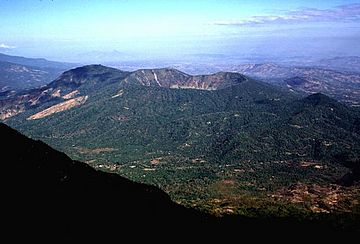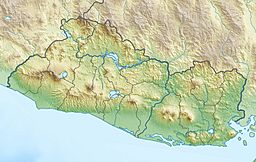Chinameca (volcano) facts for kids
Quick facts for kids Chinameca |
|
|---|---|

Chinameca stratovolcano is seen here from the SE near the summit of neighboring San Miguel volcano.
|
|
| Highest point | |
| Elevation | 1,300 m (4,300 ft) |
| Geography | |
| Location | San Miguel Department, El Salvador |
| Geology | |
| Mountain type | Stratovolcano |
| Last eruption | Unknown |
Chinameca (also known as El Pacayal) is a large, cone-shaped volcano in central-eastern El Salvador. It is a type of volcano called a stratovolcano, which means it's built up over time by many layers of hardened lava and ash. This volcano is located north of the San Miguel volcano and stands tall over the nearby town of Chinameca.
The top of Chinameca volcano has a huge bowl-shaped area called a caldera, which is about 2 kilometers (1.2 miles) wide. This caldera is known as Laguna Seca el Pacayal. On the western side of the volcano, there's a smaller peak called Cerro el Limbo. This peak is a satellite cone, meaning it's a smaller volcano that grew on the side of the main one, and it's even taller than the rim of the caldera. You can find fumaroles, which are vents that release steam and volcanic gases, on the northern side of Chinameca. Because of this heat, the area has been explored for geothermal energy, which uses heat from the Earth to make electricity.
Contents
What is a Stratovolcano?
A stratovolcano, like Chinameca, is also known as a composite volcano. These volcanoes are usually tall and have a classic cone shape. They are formed by many eruptions over thousands of years. Each eruption adds new layers of lava, ash, and rock fragments.
How Stratovolcanoes Form
Stratovolcanoes form when magma (molten rock) from deep inside the Earth rises to the surface. The magma often contains a lot of gas, which makes eruptions explosive. When these eruptions happen, they send ash, rocks, and thick lava flowing down the sides of the volcano. Over time, these layers build up, creating the steep slopes and pointed top that stratovolcanoes are known for.
Laguna Seca el Pacayal: The Caldera
The large, sunken area at the top of Chinameca is called a caldera. A caldera forms when a volcano's magma chamber empties during a large eruption. Without the support of the magma, the ground above collapses inward, creating a huge depression.
A Dry Lakebed
The caldera on Chinameca is named Laguna Seca el Pacayal, which means "Dry Lake of Pacayal." This name suggests that it might have once held a lake, or perhaps it only holds water during very rainy seasons. Calderas can sometimes fill with water to form beautiful crater lakes, but this one is mostly dry.
Geothermal Energy Exploration
The presence of fumaroles on Chinameca volcano is a sign of heat beneath the Earth's surface. This heat can be used to create clean energy.
Using Earth's Heat for Power
Geothermal exploration involves looking for places where the Earth's heat can be captured. Engineers drill wells into the ground to reach hot water or steam. This hot water or steam is then used to spin turbines, which generate electricity. Chinameca's volcanic activity makes it a good spot for this type of energy production. It's a way to get power without burning fossil fuels, which is better for the environment.
See also
- List of volcanoes in El Salvador
 In Spanish: Volcán Chinameca para niños
In Spanish: Volcán Chinameca para niños


